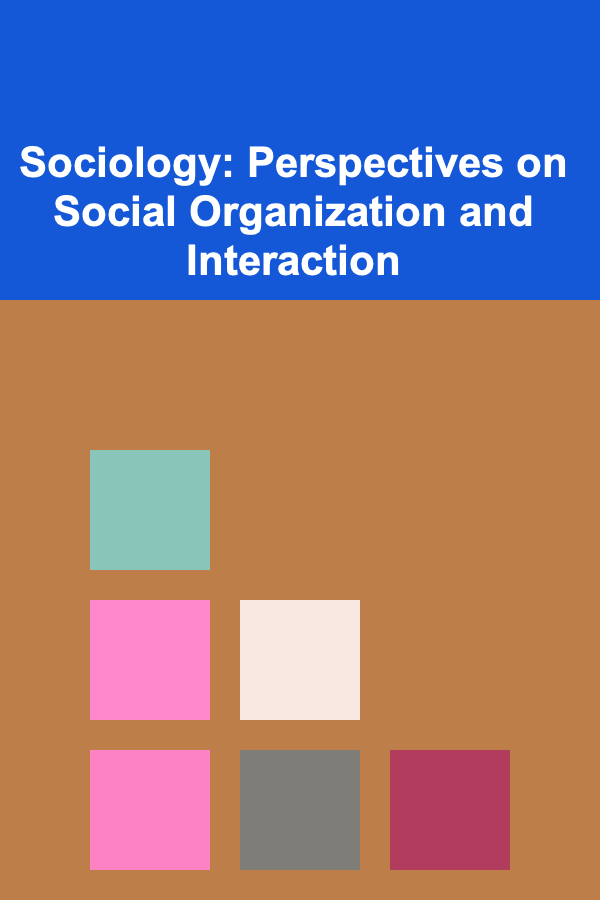
Sociology: Perspectives on Social Organization and Interaction
ebook include PDF & Audio bundle (Micro Guide)
$12.99$5.99
Limited Time Offer! Order within the next:

Sociology, the scientific study of society and human behavior, delves into the structures, relationships, and processes that shape how individuals interact with each other and how societies are organized. From small groups to large institutions, sociology offers various perspectives to understand the complexities of human interaction. One key area of study in sociology is the exploration of social organization and social interaction. These concepts are central to understanding how society operates and how individuals navigate through it.
In this guide, we will explore several perspectives on social organization and interaction, from the foundational theoretical frameworks to modern interpretations. Understanding these sociological perspectives is crucial for analyzing the intricacies of human behavior within different social contexts and for addressing the challenges posed by social inequality, power dynamics, and cultural norms.
Theoretical Foundations of Social Organization
Social organization refers to the structured patterns of relationships that govern how individuals within a society interact with one another. These structures, such as institutions, roles, norms, and rules, shape the behavior of individuals and groups. Several sociological theories offer different lenses through which we can understand how societies organize themselves.
Structural Functionalism
Structural functionalism, developed by sociologists like Émile Durkheim and Talcott Parsons, is one of the foundational perspectives in sociology. According to this theory, society is like an organism with various interconnected parts, each serving a specific function. The stability of society depends on how well these parts---such as family, education, economy, and religion---work together to maintain equilibrium.
From a structural functionalist perspective, social organizations are necessary for societal stability. Institutions help fulfill societal needs and ensure order. For instance, education systems socializing young people into societal norms, or the family providing emotional and financial support to its members. If any part of the system is disrupted, it can cause instability.
However, critics of structural functionalism argue that it tends to overlook social inequalities and power imbalances. It assumes that all parts of society are functional and beneficial, ignoring how social structures might serve the interests of powerful groups at the expense of others.
Conflict Theory
Conflict theory, rooted in the works of Karl Marx, offers a stark contrast to structural functionalism. Whereas functionalism emphasizes consensus and stability, conflict theory focuses on power, inequality, and struggle. According to this perspective, society is organized around the distribution of power and resources, with different groups competing to maintain or improve their positions.
From a conflict perspective, social organizations are shaped by power dynamics. Institutions like the government, education, and the economy are seen as tools that reinforce inequality, benefiting the ruling class while marginalizing the disadvantaged. For example, in a capitalist society, the economic system is structured to prioritize the interests of the wealthy, while working-class individuals struggle to meet basic needs.
Conflict theory highlights the role of social conflict in shaping society and social change. Instead of viewing social organizations as inherently stable or functional, this perspective sees them as sites of ongoing struggle where individuals and groups push for power and resources. This theory has been instrumental in analyzing issues like class, race, gender, and the mechanisms of social control.
Symbolic Interactionism
Symbolic interactionism, developed by George Herbert Mead and Herbert Blumer, focuses on the small-scale interactions between individuals and groups. Unlike the macro-level approaches of structural functionalism and conflict theory, symbolic interactionism emphasizes the symbolic meanings that individuals attach to objects, events, and behaviors in their everyday lives.
According to symbolic interactionism, social order and organization are created through the shared meanings that individuals negotiate during interactions. For instance, the way people communicate with one another, the roles they assume in different contexts, and the symbols they use all contribute to the construction of social reality. A classic example of this is the concept of "the self," which is shaped through social interaction. Individuals develop their identity based on how they are perceived by others and how they interpret those perceptions.
Symbolic interactionism is particularly valuable for understanding micro-level social dynamics, such as how people form relationships, develop norms, and create social roles. It highlights the fluid and dynamic nature of social interaction and challenges the idea that social structures are rigid or unchanging.
Social Exchange Theory
Social exchange theory, influenced by the work of George Homans and Peter Blau, offers a perspective that views social interaction as a process of negotiation, where individuals seek to maximize rewards and minimize costs. This theory operates on the principle of rational choice, assuming that people make decisions based on the benefits they expect to gain from interactions.
In social exchanges, individuals weigh the costs and benefits of relationships, whether personal or professional. For example, in a friendship, one may assess the emotional support and companionship offered versus the time and energy invested. This theory helps explain patterns of cooperation, competition, and reciprocity in social relationships.
While social exchange theory offers valuable insights into the rational aspects of social behavior, it has been criticized for oversimplifying human interaction by focusing solely on individual self-interest. It also does not account for the complexities of social structures and inequalities that shape individuals' ability to make free choices.
Social Interaction: The Role of Social Context
While social organization provides a framework for understanding societal structure, social interaction is the dynamic process through which individuals engage with one another. Social interaction involves the exchange of verbal and non-verbal cues, the negotiation of roles, and the construction of shared meanings.
The Importance of Social Roles
One of the key concepts in understanding social interaction is the idea of social roles. A social role is a set of expectations associated with a particular position within society. For example, a teacher has a role that involves instructing students, grading assignments, and maintaining discipline. Similarly, a student has a role that involves attending class, completing assignments, and interacting with peers.
Roles provide structure to social interaction, as individuals often modify their behavior based on the expectations tied to these roles. However, the expectations associated with roles can vary depending on social context, cultural norms, and individual identity. Role conflict occurs when an individual faces competing demands from different roles (e.g., balancing work and family obligations).
Social Norms and Conformity
Social norms are the unwritten rules that govern behavior within a society or group. They dictate what is considered acceptable or unacceptable in various situations, and they help maintain order in social interactions. For example, norms regarding politeness, dress codes, or punctuality shape how people behave in public settings.
Conformity to social norms is a central aspect of social interaction. People often conform to norms because they fear social rejection or desire to fit in. However, social norms are not fixed---they can change over time and may vary across different cultures or subgroups. Sociologists study how norms evolve and the factors that influence conformity, such as peer pressure, media, and cultural values.
Socialization and Identity Formation
Socialization is the process through which individuals learn and internalize the values, beliefs, and behaviors of their society. Through socialization, individuals come to understand their roles in the social structure and develop a sense of self and identity. This process occurs through interactions with family, peers, schools, and media.
Socialization plays a significant role in shaping individuals' understanding of social norms, values, and expectations. It influences everything from gender roles to cultural practices to political ideologies. As individuals grow and interact with different social groups, their identity evolves, reflecting the interplay between personal experiences and societal influences.
Conclusion
Sociology offers diverse perspectives on social organization and interaction, each providing unique insights into how societies are structured and how individuals navigate their social worlds. From the macro-level analysis of institutions and power dynamics in conflict theory to the micro-level focus on everyday interactions in symbolic interactionism, these perspectives provide tools for understanding the complexities of human behavior.
Social organization and interaction are not static; they are dynamic, evolving, and shaped by a variety of social, cultural, and historical forces. By studying these processes, we gain a deeper understanding of the ways in which social structures influence individuals and how individuals, in turn, shape the structures around them. Whether we are addressing issues of inequality, power, or identity, sociology provides a critical framework for understanding the forces that shape our world.

How to Choose the Right Furniture for Optimal Dining Room Functionality
Read More
How to Organize Your Podcast Library for Easy Listening
Read More
How to Stage Your Home with Temporary Changes
Read More
How to Utilize Calendar Apps for Better Organization
Read More
The Video Editor's Playbook: Essential Skills for Cutting, Crafting, and Creating Compelling Content
Read More
How to Start a Craft Beer Collection: A Comprehensive Guide
Read MoreOther Products

How to Choose the Right Furniture for Optimal Dining Room Functionality
Read More
How to Organize Your Podcast Library for Easy Listening
Read More
How to Stage Your Home with Temporary Changes
Read More
How to Utilize Calendar Apps for Better Organization
Read More
The Video Editor's Playbook: Essential Skills for Cutting, Crafting, and Creating Compelling Content
Read More